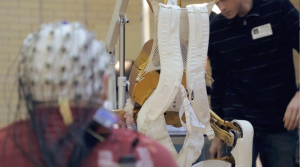All too often, a stroke can mean total loss of mobility for the patient. For years, this has been accepted as a reality for stoke victims, but for Jose Luis “Pepe” Contreras-Vidal, professor of electrical and computer engineering at the University of Houston Cullen College of Engineering, losing the ability to walk after a stroke is simply a roadblock to regaining full mobility – one which can and will be overcome.
A leading figure in the field of brain-machine interface systems, Contreras-Vidal develops algorithms that can read electrical activity in the brain and translate that activity into movement intentions that drive robotic exoskeletons and advanced prosthetic limbs. Now, Contreras-Vidal is collaborating with NASA and TIRR Memorial Hermann to test his cutting-edge invention out on stroke and paralysis patients with limited or no use of their legs.
Contreras-Vidal is testing his noninvasive brain-machine interface “cap” with the NASA-developed X1exoskeleton, which is a light-weight, wearable robot originally designed as an exercise tool for crew members on the International Space Station. The hope is that stroke and other patients with mobility issues could use the X1 to help them regain the ability to walk. In the coming months, the team will be starting a clinical trial to test the use of the X1 as a physical therapy tool for stroke patients.
Patients are strapped into the robotic “legs” that communicate with a non-invasive brain-scanning helmet, and as they activate the part of the brain used to walk, the exoskeleton begins to move their legs forward. Contreras-Vidal hopes that after the patient uses the robot routinely, their brain will begin to re-learn the walking motion and they will eventually become fully mobile – without technological assistance.
Contreras-Vidal recently exhibited the Brain-Machine Interface System at the TIRR Memorial Hermann Research Center. Watch him explain first-hand the effect of the robotic exoskeleton on his patients below.
